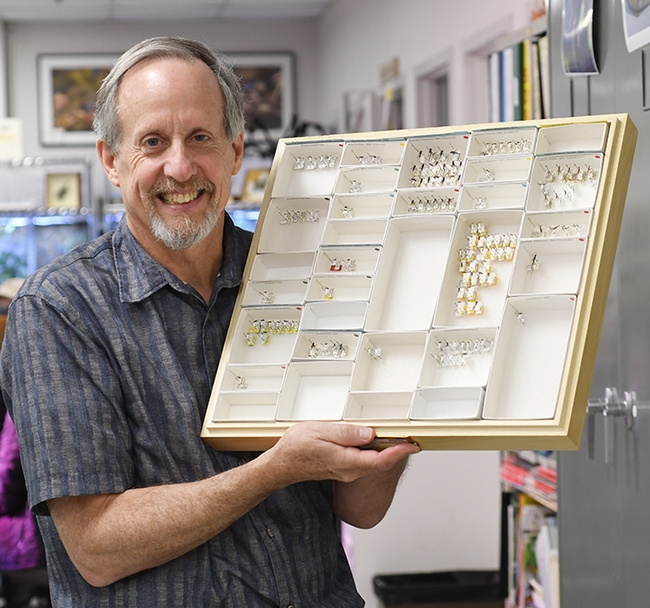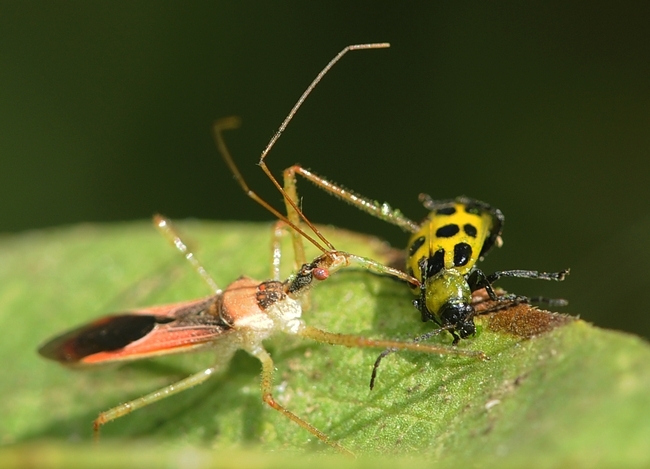- Author: Kathy Keatley Garvey
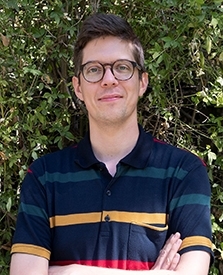
What better way to celebrate Aggie Spirit Week, Oct. 10-16, on the UC Davis campus than to
- See specimens and live insects at the Bohart Museum of Entomology during the week, Oct. 10-13?
- Attend a Bohart Museum-hosted lecture on scientific illustrator Mary Foley Benson on Saturday, Oct. 15?
- Attend a Bohart open house themed "Insects, Art and Culture" on Saturday, Oct. 15?
Aggie Spirit Week, which began Monday, Oct. 10 and continues through Sunday, Oct. 16, is a celebration of "Homecoming, The Golden Society, Parent and Family Weekend and campus-wide events for Aggies across the globe," officials said.
Spirit Week. The Bohart Museum, home of a worldwide collection of eight million insect specimens, a live "petting zoo" (Madagascar hissing cockroaches stick insects and tarantulas), and a gift shop stocked with insect-themed items, is participating in Aggie Spirit Week four days this week (Monday through Thursday). Hours are from 9 a.m. to noon and from 1 to 5 p.m. The insect museum is located in Room 1124 of the Academic Surge Building on Crocker Lane.
Open House! On Saturday, Oct. 15, a special open house on "Insects, Art and Culture" will take place from 1 to 4 p.m. in the Bohart Museum. It's free and family friendly. "Come and learn about insects through the lenses of art and culture," said Tabatha Yang, education and outreach coordinator. "This event is part of Spirit Week for Aggie students, parents and alumni, but all are welcome."
Seminar on Mary Foley Benson. One of the highlights of Aggie Spirit Week will be a seminar on the life and work of noted scientific illustrator Mary Foley Benson.Srdan Tunic, a candidate for a master's degree in art history, will present the seminar from 11 a.m. to noon, Oct. 15, in Room 1010 TLC Teaching and Learning Complex, 482 Hutchison Drive.
Benson (1905-1992), internationally known for her entomology and horticulture illustrations, served as scientific illustrator for the U.S. Department of Agriculture's Bureau of Entomology and the Smithsonian Institution. Later, as a resident of Davis, she engaged in other projects, including working for UC Davis entomologists. Much of her work appears in campus buildings, including Briggs Hall, home of the Davis Department of Entomology and Nematology, and the Bohart Museum of Entomology. (See research story on Mary Foley Benson by forest entomologist Malcolm Furniss)
Tunic has spent the last year researching her life and work. He is one of the co-founders of initiatives Street Art Walks Belgrade, Kustosiranje / About and Around Curating. A graduate of the University of Belgrade and University of the Arts in Belgrade, Serbia, he holds degrees in both art history and cultural management. He anticipates receiving his master's degree from UC Davis in June 2023.
History of Bohart Museum. The UC Davis museum, founded in 1946 by noted entomologist Richard M. Bohart (1913-2007), is dedicated to teaching, research and service. It originated with two Schmitt boxes of insect specimens that Bohart had collected. The university named it the R. H. Bohart Museum of Entomology in 1982. Its insect collection is now the seventh largest in North America and includes terrestrial and fresh water arthropods. The museum is also home of the California Insect Survey, a storehouse of the insect biodiversity of California's deserts, mountains, coast, and the Great Central Valley.
Directed by Lynn Kimsey, UC Davis distinguished professor of entomology, the insect museum is open to the public year-around (except for holidays) Monday through Thursday from 9 a.m. to noon an from 1 to 5 p.m. It is closed to the public on Friday to enable research activities. Admission is free. For more information, access the website or contact the museum at bmuseum@udavis.edu.
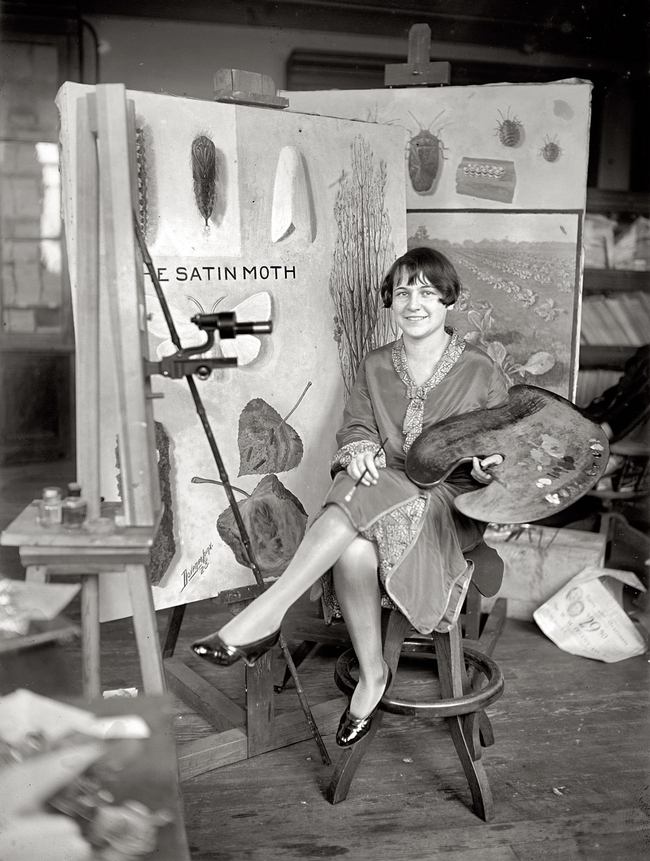
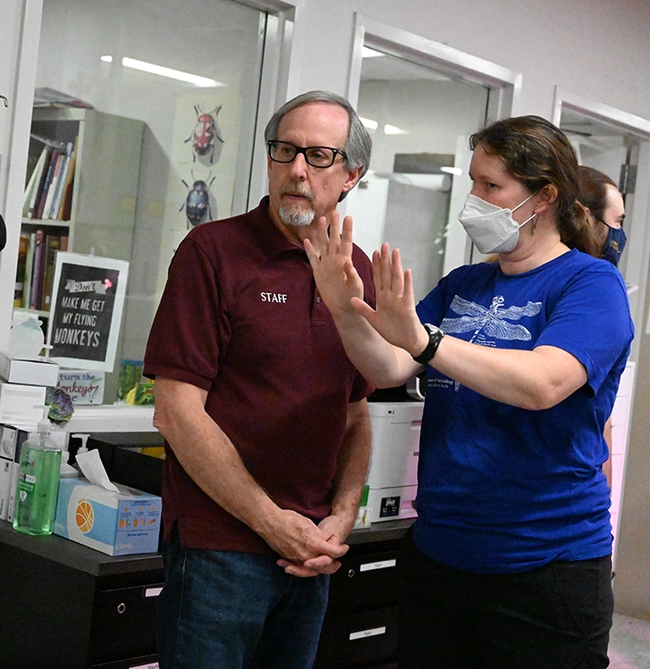
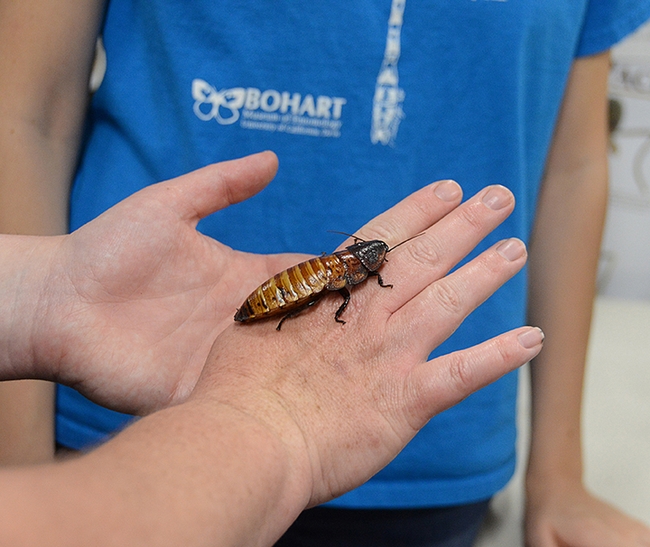
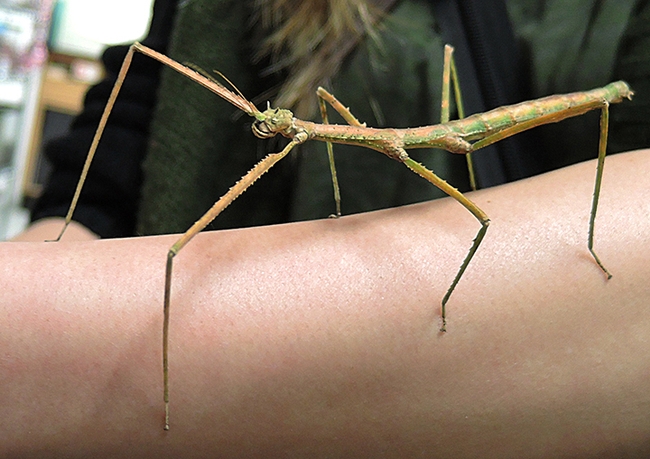
- Author: Kathy Keatley Garvey
Honey bees weren't the only insects at the 2022 California Honey Festival, held Saturday, May 7 in downtown Woodland.
Walking sticks, aka stick insects, grabbed some of the attention, too.
Officials at the Bohart Museum of Entomology, UC Davis, brought along display cases of bee specimens that showed the diversity of bees. They also brought along stick insects for visitors to hold and photograph.
UC Davis undergraduate students Lauren Spellman and Pichawi "Salee" Sangrawiakararat delighted in holding the Peruvian stick insects. Both are first-year students. Lauren is majoring in environmental sciences while Salee is undeclared. When someone suggested that Salee might consider majoring in entomology (science of insects), she smiled.
The Bohart Museum of Entomology, directed by Lynn Kimsey, UC Davis distinguished professor of entomology, houses a worldwide collection o 8 million insect specimens. It also includes a gift shop, stocked with insect-themed gifts such as hoodies, t-shirts, books, posters, and jewelry; and its popular live "petting zoo," comprised of Madagascar hissing cockroaches, stick insects and tarantulas.
The Bohart, located in Room 1124 of the Academic Surge Building on Crocker Lane, is newly opened to the public this spring after two years of COVID-19 pandemic restrictions. Groups must make reservations and everyone must follow the UC Davis visitor guidelines.
Upcoming weekend programs, free and open to the public:
- Saturday, May 28, 1 to 4 p.m.
"Bugs in Ag: What Is Eating Our Crops and What is Eating Them?" - Saturday, June 25, 1 to 4 p.m.
"8-legged Wonders" -
Saturday, July 16. 1 to 4 p.m.
"Celebrating 50 Years of the Dogface Butterfly: California's State Insect"
Local Spider Information (Essig Museum of Entomology)
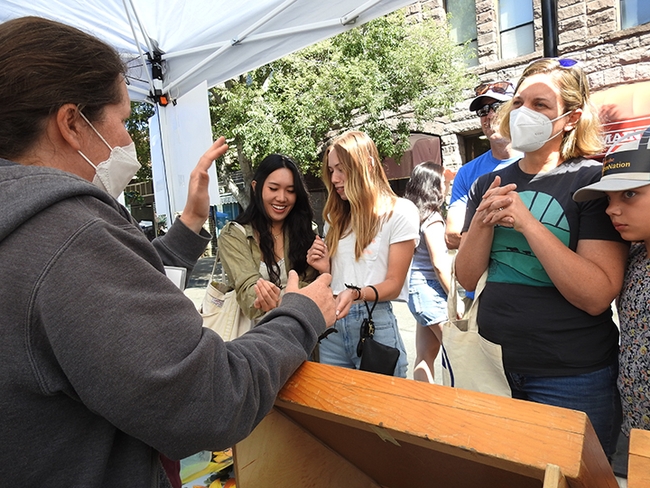
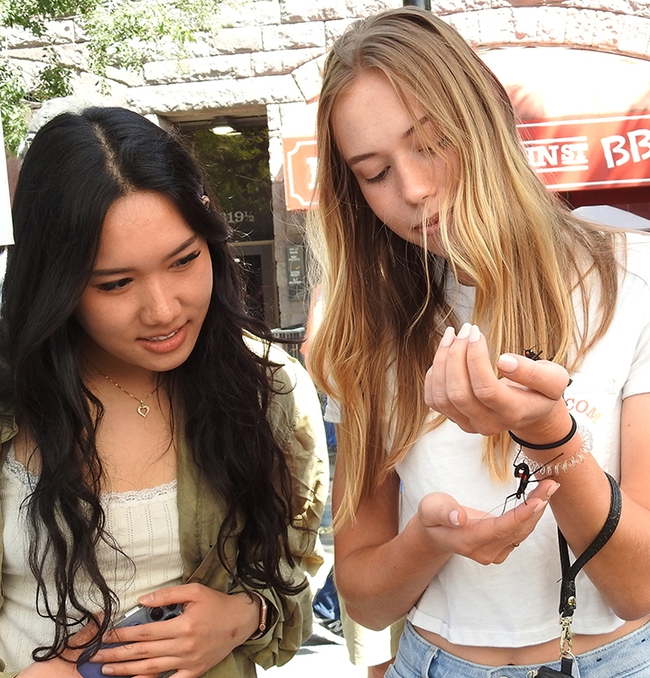
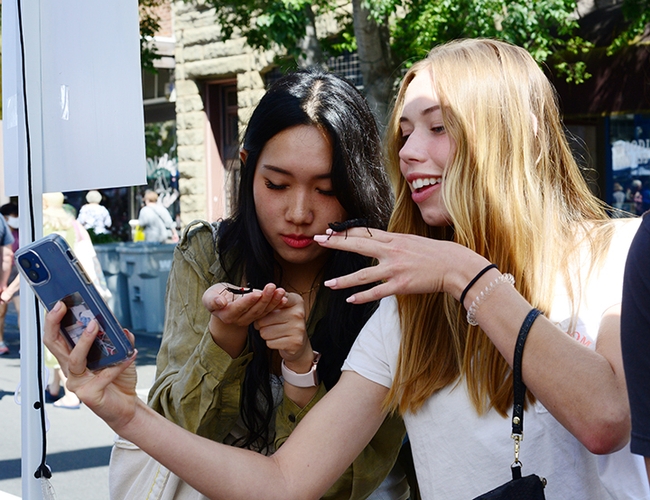
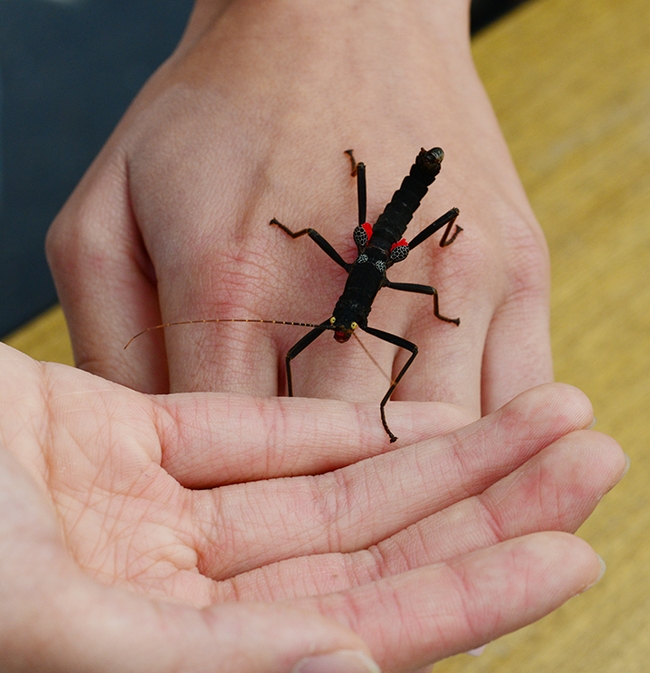

- Author: Kathy Keatley Garvey
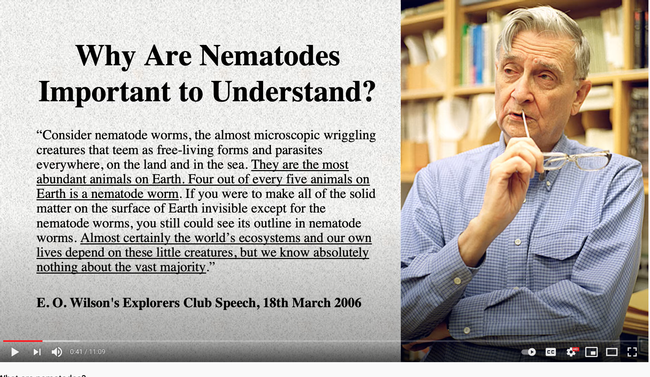
That's a question that nematologists are frequently asked.
Well, just in time for the UC Davis Biodiversity Museum Month (that would be our month of February!), nematologist Steve Nadler, professor and chair of the UC Davis Department of Entomology and Nematology, answers that very question in his 11-minute YouTube video, https://youtu.be/3fhv-P_O8I8. .
Nematodes are known as "round worms" and most are microscopic, he says in his family friendly, easy-to-understand video.
"The famous naturalist E. O. Wilson who studies ants notes that 80 of the individual animals living on the earth are nematodes," Nadler says. "They are clearly important to the earth's ecosystems, even if we don't fully understand all the things that they do, and as parasites they affect human health, the health of other animals, and reduce our food production so they're clearly important in that respect."
You'll want to watch the rest of it.
Nematodes are just one of the topics of videos posted on the UC Davis Biodiversity Museum Month website. Others affiliated with the UC Davis Department of Entomology and Nematology focus on butterflies, moths, arachnids, millipedes, and how to collect, preserve and identify insects.
Other videos posted on this site for free, public viewing include:
- "Virtual Tour of the Bohart's Lepidoptera Collection," a 13-minute Aggie Video by Diane Ullman, professor and former chair of the UC Davis Department of Entomology and Nematology. She describes the natural history and ecology of several colorful and toxic species in the Bohart Museum of Entomology. See https://bit.ly/2LHYFzL
- "Insect Collection, Preservation and Identification," a 15-minute Aggie Video by Steve Heydon, senior museum scientist, Bohart Museum of Entomology. Heydon, the curator and collections manager of the Bohart Museum, gives an overview of how the museum collects, preserves and identifies some of its nearly 8 million specimens. See https://bit.ly/375eXdC
- "Common Millipedes of the Sacramento-San Francisco Region," a 23-minute YouTube video by Xavier Zahnle, a doctoral student in the lab of Professor Jason Bond lab, the Schlinger Chair in Systematics. Zahnle reviews the major groups of millipedes that are commonly found in the region, the diversity, and what makes them unique. See https://youtu.be/ZMAzm3A95VE
- "Demonstration of Insect Preparation: Butterflies and Moths," a 9-minute Aggie Video featuring Jeff Smith, curator of the Lepidoptera collection at the Bohart Museum of Entomology. He describes how to pin and spread moths and butterflies. This technique is the most common method that museums and researchers use to display adult Lepidopterans, allowing scientists to identify and study this diverse group of insects. See https://video.ucdavis.edu/media/0_9nymgt3c
- "All About Arachnids," a 24-minute YouTube video by Lacie Newton, a doctoral student in the lab of Professor Jason Bond lab, the Schlinger Chair in Systematics. She talks about the diversity of arachnids (spiders, scorpions, ticks, mites etc.) and their unique characteristics. https://youtu.be/FM_ANqARkI0
Other topics range from the Phaff Yeast Collection, California Raptor Center and the Museum of Wildlife and Fish Biology to the UC Davis Arboretum and Public Garden. More videos, including one on the diversity of bees by Chris Casey, manager of the UC Davis Department of Entomology and Nematology's bee garden, the Häagen-Dazs Honey Bee Haven, are being loaded throughout the month of February. To access all of the pre-recorded videos and activities, click here. To access the schedule of live talks and demonstrations, click here.
About the UC Davis Biodiversity Museum Month
The 10th annual UC Davis Biodiversity Museum Month program is all virtual this year via webinars and pre-recorded presentations. All take place throughout the month of February. The science-based event traditionally occurs on only one day--the Saturday of Presidents' Weekend, when families and friends gather on campus to learn first-hand about the UC Davis museums and collections.
This year's biodiversity event focuses on 12 museums or collections:
- Anthropology Museum
- Arboretum and Public Garden
- Bohart Museum of Entomology
- Botanical Conservatory
- California Raptor Center
- Center for Plant Diversity
- Häagen-Dazs Honey Bee Haven
- Nematode Collection
- Marine Invertebrate Collection
- Museum of Wildlife and Fish Biology
- Paleontology Collection
- Phaff Yeast Culture Collection
One of the activities listed in the pre-recorded talks and activities is a 10-page coloring book on plant-insect interactions. It's the work of Molly Barber, Fernanda Guizar, Collin Gross and Jasen Liu of the Santiago Ramirez lab, UC Davis Department of Evolution and Ecology. Ramirez is a global authority on orchid bees. Download the PDF of the coloring book here.
To help support the Biodiversity Museum event, contributions are being accepted through a month-long crowdfunding campaign program at https://crowdfund.ucdavis.edu/project/24310.
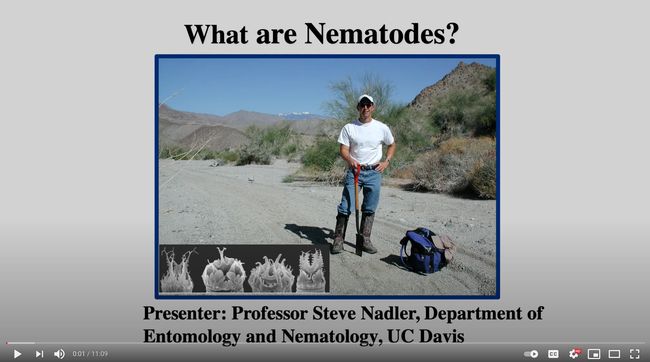
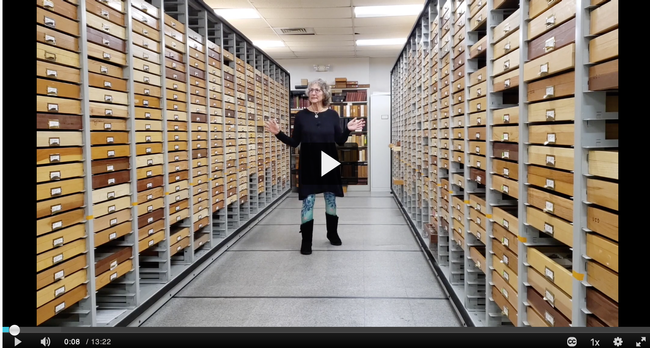
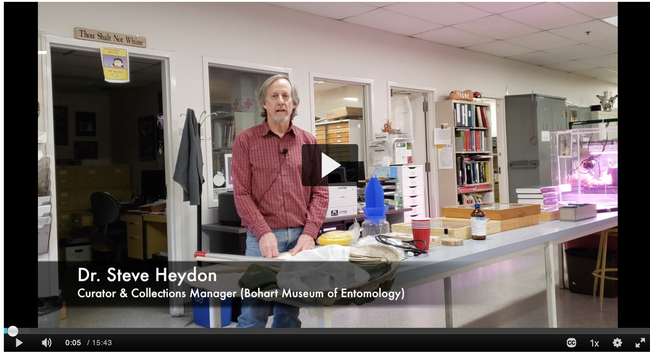
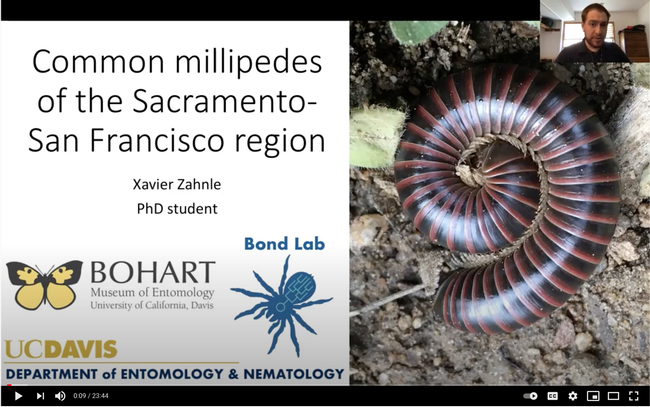
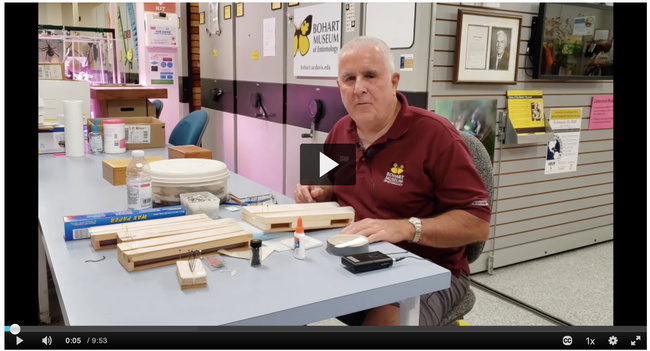
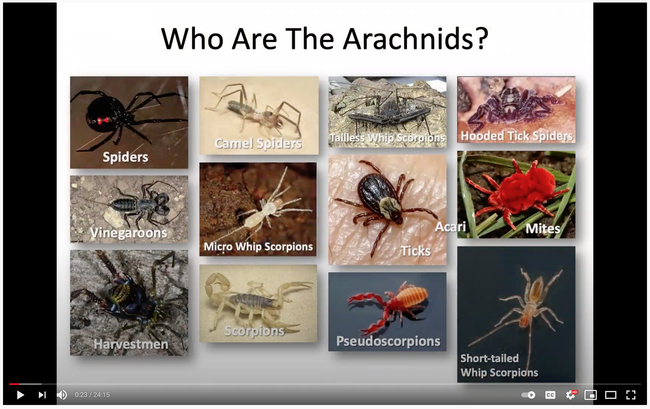
- Author: Kathy Keatley Garvey
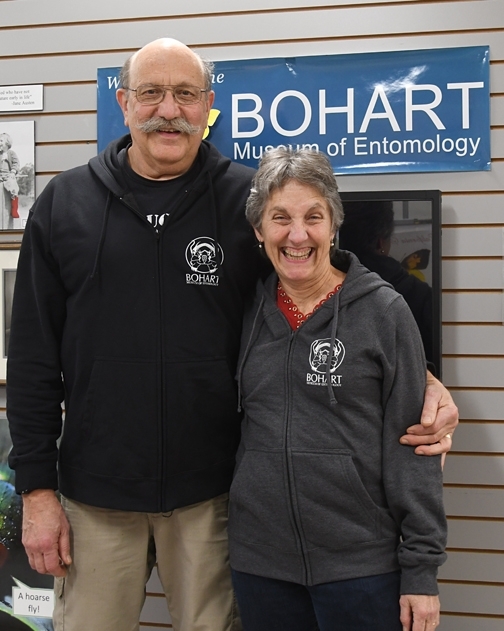
It certainly did the insect museum, the Bohart Museum of Entomology at the University of California, Davis.
Although the museum, located in Room 1124 of the Academic Surge Building, Crocker Lane, is closed to the public due to COVID-19 pandemic precautions, it's gearing up for the holiday season with online sales from the gift shop, which is stocked with insect-themed t-shirts, hoodies, jewelry, posters, books, insect-collecting equipment and other items. (See gift shop inventory)
“Your support enables us to fulfill our mission of documenting and supporting research in biodiversity, educating and inspiring others about insects, and providing state-of-the-art information to the community,” says Lynn Kimsey, director of the Bohart Museum and professor and former chair of the UC Davis Department of Entomology and Nematology.
The Bohart Museum, home of a global collection of nearly eight million insect specimens, houses the seventh largest insect collection in North America, and the California Insect Survey, a storehouse of the insect biodiversity of the state's deserts, mountains, coast, and the Great Central Valley. The Bohart is also the home of a live “petting zoo” (comprised of Madagascar hissing cockroaches, stick insects and tarantulas), and the year-around gift shop.
Here are some of the items available at the Bohart Museum:
- Earrings and necklaces (with motifs of bees, dragonflies, moths, butterflies and other insects)
-
T-shirts for babies, children and adults (walking sticks, monarch butterflies, beetles, dragonflies, dogface butterflies and the museum logo)
-
Insect candy (lollipops with either crickets and scorpions, and chocolate-covered scorpions)
-
Insect collecting equipment: bug carriers, nets, pins, boxes, collecting kits
-
Plastic insect toys and stuffed animals (mosquito, praying mantis, bed bug and others)
-
Handmade redwood insect storage boxes and handcrafted pens by Bohart Museum associate Jeff Smith
-
Posters (Central Valley butterflies, dragonflies of California, dogface butterfly), prints of selected museum specimens
-
Books by museum-associated authors:
- The Story of the Dogface Butterfly (Fran Keller, Greg Kareofelas and Laine Bauer), Insects and Gardens Insects and Gardens: In Pursuit of a Garden Ecology (Eric Grissell), Bumble Bees of North America: An Identification Guide (co-authored by Robbin Thorp), California Bees and Blooms: A Guide for Gardeners and Naturalists (co-authored by Robbin Thorp), Guide to Butterflies of the San Francisco Bay and the Sacramento Region (Art Shapiro), Butterfly Wish (Steve Stoddard, pen name S.S. Dudley), and multiple dragonfly books by Kathy Biggs
- The Story of the Dogface Butterfly (Fran Keller, Greg Kareofelas and Laine Bauer), Insects and Gardens Insects and Gardens: In Pursuit of a Garden Ecology (Eric Grissell), Bumble Bees of North America: An Identification Guide (co-authored by Robbin Thorp), California Bees and Blooms: A Guide for Gardeners and Naturalists (co-authored by Robbin Thorp), Guide to Butterflies of the San Francisco Bay and the Sacramento Region (Art Shapiro), Butterfly Wish (Steve Stoddard, pen name S.S. Dudley), and multiple dragonfly books by Kathy Biggs
- Bohart logos (youth tshirts, stickers and patches)
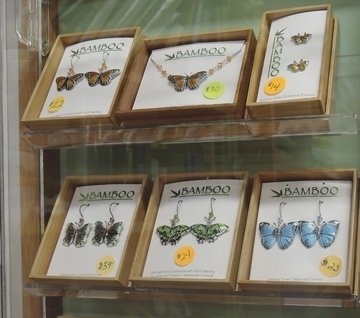
Also available are gift memberships and the ability--through donations to the biolegacy program--to name insect species.
The Bohart Museum of Entomology, founded in 1946 and dedicated to teaching, research and service, is named for noted entomologist Richard Bohart, who taught entomology at UC Davis for more than 50 years, beginning in 1946, and chaired the Department of Entomology from 1963-1967.
Said Kimsey: "His publications include three of the most important books on the systematics of the Hymenoptera, including the well-used volume Sphecid Wasps of the World. His journal publications total over 200 articles. He revised many groups of insects, discovered new host-associations or geographic ranges, and described many new species."
For more information, email the Bohart Museum at bmuseum@ucdavis.edu or access the website at http://bohart.ucdavis.edu.
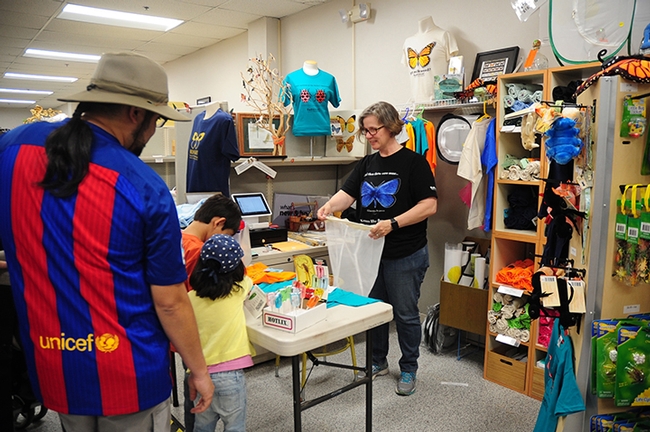
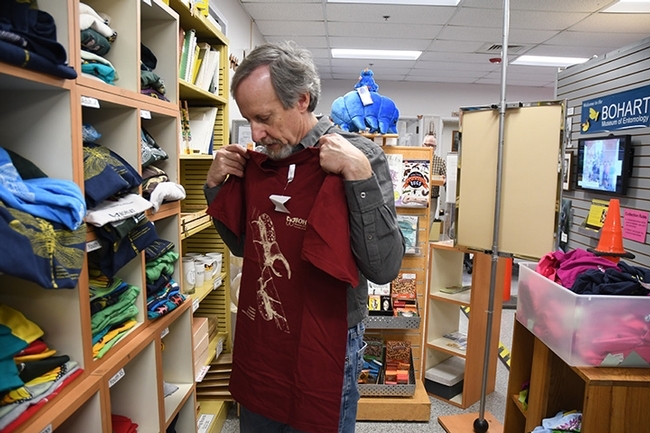
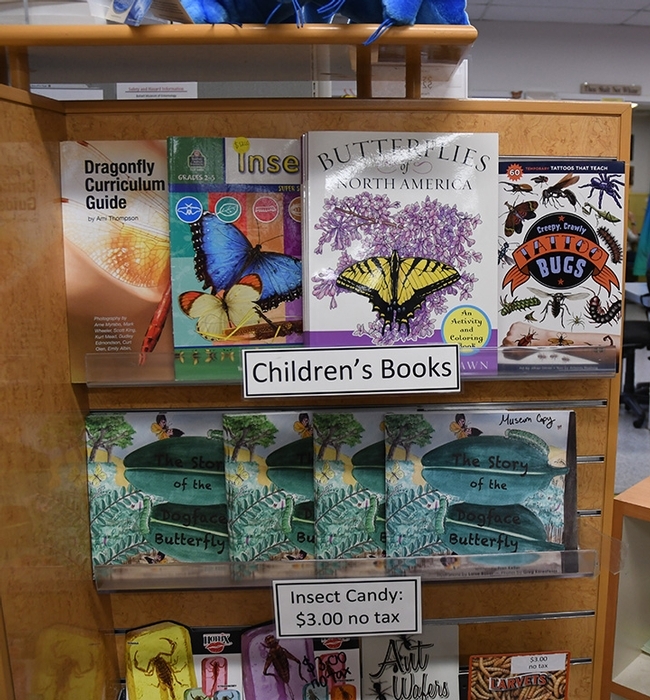
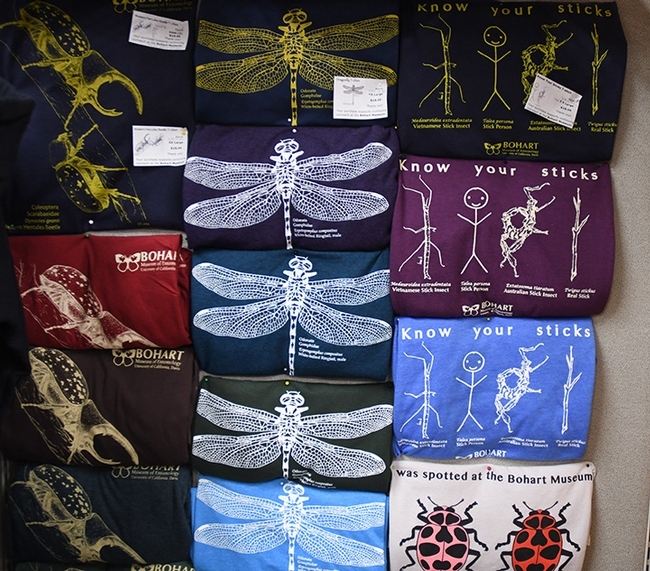
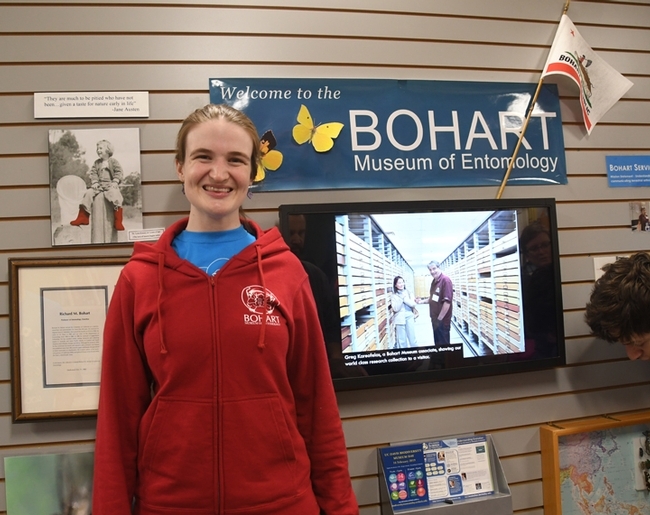
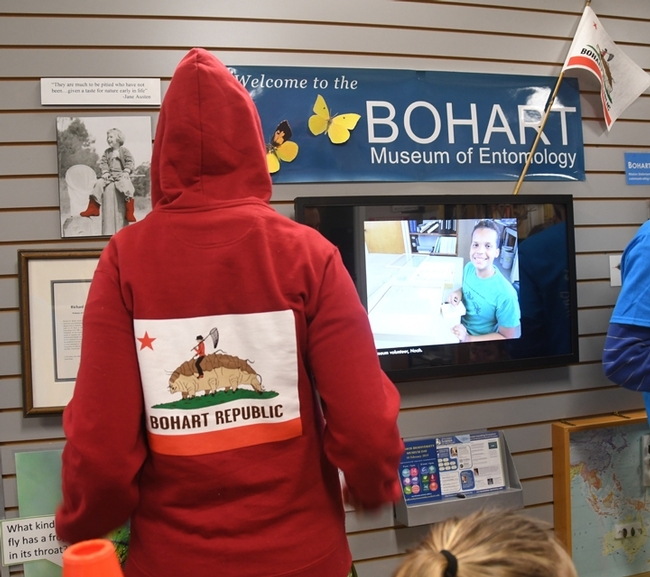
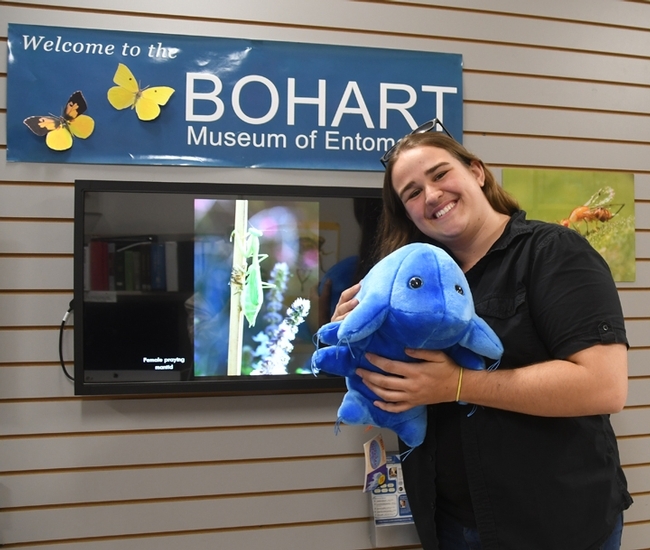
- Author: Kathy Keatley Garvey
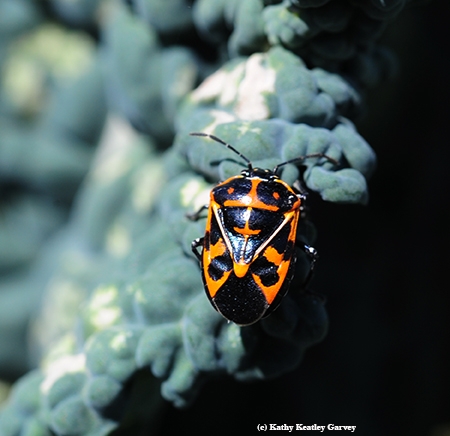
But the Bohart Museum of Entomology open house on "Parasitoid Palooza" on Saturday, Oct. 19 from 1 to 4 p.m. promises to provide a touch of Halloween, what with all the Halloween decorations and the pests that eat pumpkins and the parasitoids that eat their hosts.
The open house, free and family friendly, takes place in Room 1125 of the Academic Surge Building on Crocker Lane, UC Davis campus.
"We will celebrate all things parasitoid with (senior museum scientist) Steve Heydon and with some parasite input from (graduate student) Socrates Letana," said Tabatha Yang, education and outreach coordinator. Heydon, who researches Pteromalids or jewel wasps, will display his work and answer questions.
There are some 3,450 described species of Pteromalids, found throughout the world and in virtually all habitats. Many are important as biological control agents.
"An insect parasitoid is a species whose immatures live off of an insect host, often eating it from the inside out," Yang said. "It is part of their life cycle and the host generally dies."
Also planned:
- Display of pumpkin-eating pests orange from Jasmin Ramirez Bonilla of the Ian Grettenberger lab, UC Davis Department of Entomology and Nematology. These include the orange and black Harlequin bugs and cucumber beetles (See UC Statewide Integrated Pest Management Program website)
- Family craft activity: no sew, sock caterpillars with parasitoid eggs on the outside.
- Sampling of Chirp Chips, from the Bohart Museum's recent entomophagy open house
The Bohart Museum, directed by Lynn Kimsey, professor of entomology at UC Davis, houses a global collection of nearly eight million specimens. It is also the home of the seventh largest insect collection in North America, and the California Insect Survey, a storehouse of the insect biodiversity.
Special attractions include a “live” petting zoo, featuring Madagascar hissing cockroaches, walking sticks, praying mantids and tarantulas. Visitors are invited to hold some of the insects and photograph them. The museum's gift shop, open year around, includes T-shirts, sweatshirts, books, jewelry, posters, insect-collecting equipment and insect-themed candy.
The Bohart Museum holds special open houses throughout the academic year. Its regular hours are from 9 a.m. to noon and 1 to 5 p.m. Mondays through Thursdays. The museum is closed to the public on Fridays, Saturdays and Sundays and on major holidays. Admission is free.
More information on the Bohart Museum is available by contacting (530) 752-0493 or emailing bmuseum@ucdavis.edu or Tabatha Yang at tabyang@ucdavis.edu.
